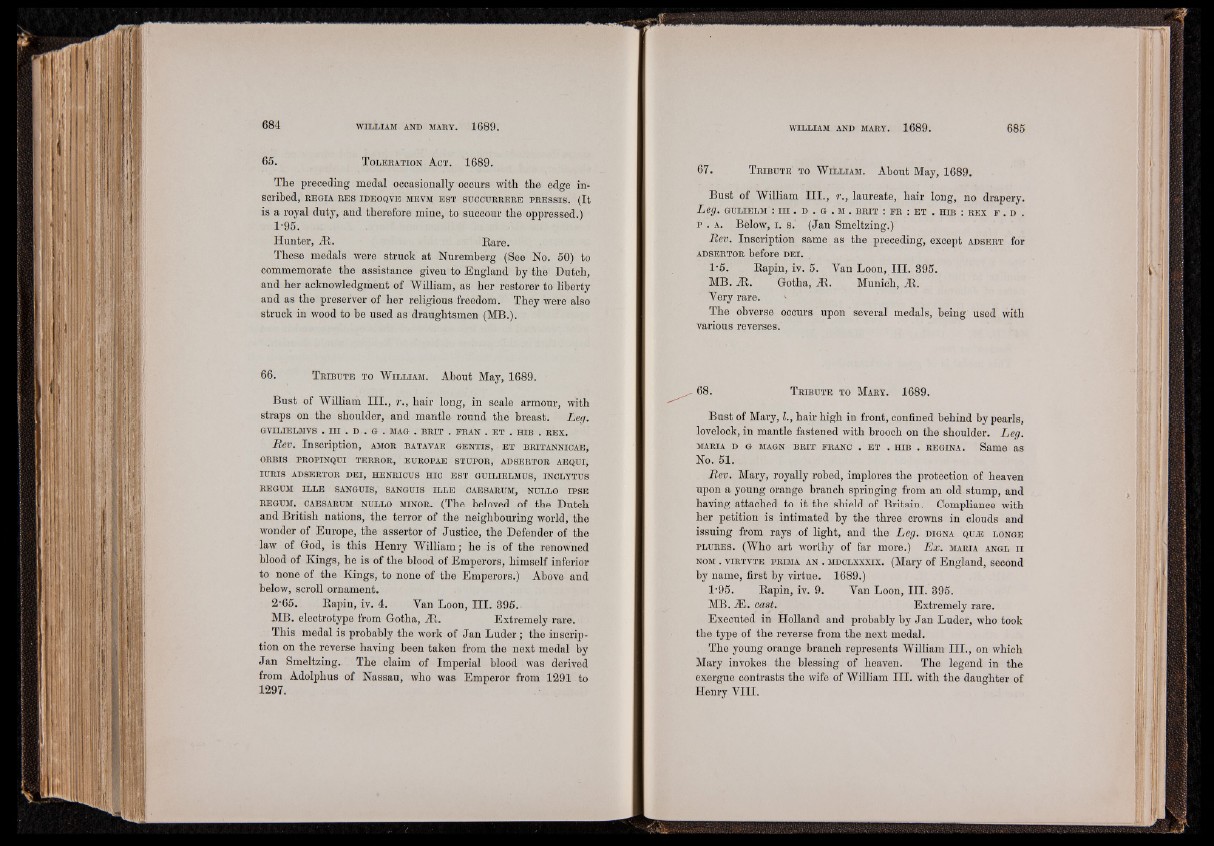
65. T o l e r a t io n A c t . 1689.
The preceding medal occasionally occurs with the edge inscribed,
REGIA RES IDEOQVE MEVM EST SUCCURRERE PRESSIS. (It
is a royal duty, and therefore mine, to succour the oppressed.)
1-95.
Hunter, iR. Rare.
These medals were struck at Nuremberg (See No. 50) to
commemorate the assistance given to England by the Dutch,
and her acknowledgment of William, as her restorer to liberty
and as the preserver of her religious freedom. They were also
struck in wood to be used as draughtsmen (MB.).
66. T r ib u t e t o W i l l ia m . About May, 1689.
Bust of William III., r., hair long, in scale armour, with
straps on the shoulder, and mantle round the breast. Leg.
GVILIELMVS . I l l . D . G . MAG . BRIT . FRAN . ET . HIB . REX.
Rev. Inscription, am o r b a t a v a e g e n t i s , e t b r it a n n ic a e ,
ORBIS PROPINQUI TERROR, EUROPAE STUPOR, ADSERTOR AEQUI,
IURIS ADSERTOR D E I, HENRICUS HIC EST GUILIELMUS, INCLYTUS
REGUM IL LE SANGUIS, SANGUIS IL LE CAESARUM, NULLO IPSE
REGUM, CAESARUM n u l l o m in o r . (The beloved of the Dutch
and British nations, the terror of the neighbouring world, the
wonder of Europe, the assertor of Justice, the Defender of the
law of God, is this Henry William; he is of the renowned
blood of Kings, he is of the blood of Emperors, himself inferior
to none of the Kings, to none of the Emperors.) Above and
below, scroll ornament.
2'65. Rapin, iv. 4. Van Loon, III. 395.
MB. electrotype from Gotha, HI. Extremely rare.
This medal is probably the work of Jan Luder; the inscription
on the reverse having been taken from the next medal by
Jan Smeltzing. The claim of Imperial blood was derived
from Adolphus of Nassau, who was Emperor from 1291 to
1297.
67. T r ib u t e t o W i l l ia m . About May, 1689.
Bust of William III., r., laureate, hair long, no drapery.
Leg. GULIELM : I I I . D . G . M . BRIT : FR : ET . HIB : REX F . D .
p . a . Below, i. s.' (Jan Smeltzing.)
Rev. Inscription same as the preceding, except a d s e r t for
a d s e r t o r before d e i .
l -5. Rapin, iv. 5. Van Loon, III. 395.
MB. iR. Gotha, iR. Munich, Ht.
Very rare. '
The obverse occurs upon several medals, being used with
various reverses.
,• 68. T r ib u t e t o M a r y . 1689.
Bust of Mary, I., hair high in front, confined behind by pearls,
lovelock, in mantle fastened with brooch on the shoulder. Leg.
MARIA D G MAGN BRIT FRANC . ET . HIB . REGINA. Same as
No. 51.
Rev. Mary, royally robed, implores the protection of heaven
upon a young orange branch springing from an old stump, and
having attached to it the shield of Britain. Compliance with
her petition is intimated by the three crowns in clouds and
issuing from rays of light, and the Leg. d ig n a Q u a : l o n g e
p l u r e s . (Who art worthy of far more.) Ex. m a r ia a n g l i i
n om . v ir t v t e p r im a a n . m d c l x x x ix . (Mary of England, second
by name, first by virtue. 1689.)
1’95. Rapin, iv. 9. Van Loon, III. 395.
MB. iE. cast. Extremely rare.
Executed in Holland and probably by Jan Luder, who took
the type of the reverse from the next medal.
The young orange branch represents William III., on which
Mary invokes the blessing of heaven. The legend in the
exergue contrasts the wife of William III. with the daughter of
Henry VIII.